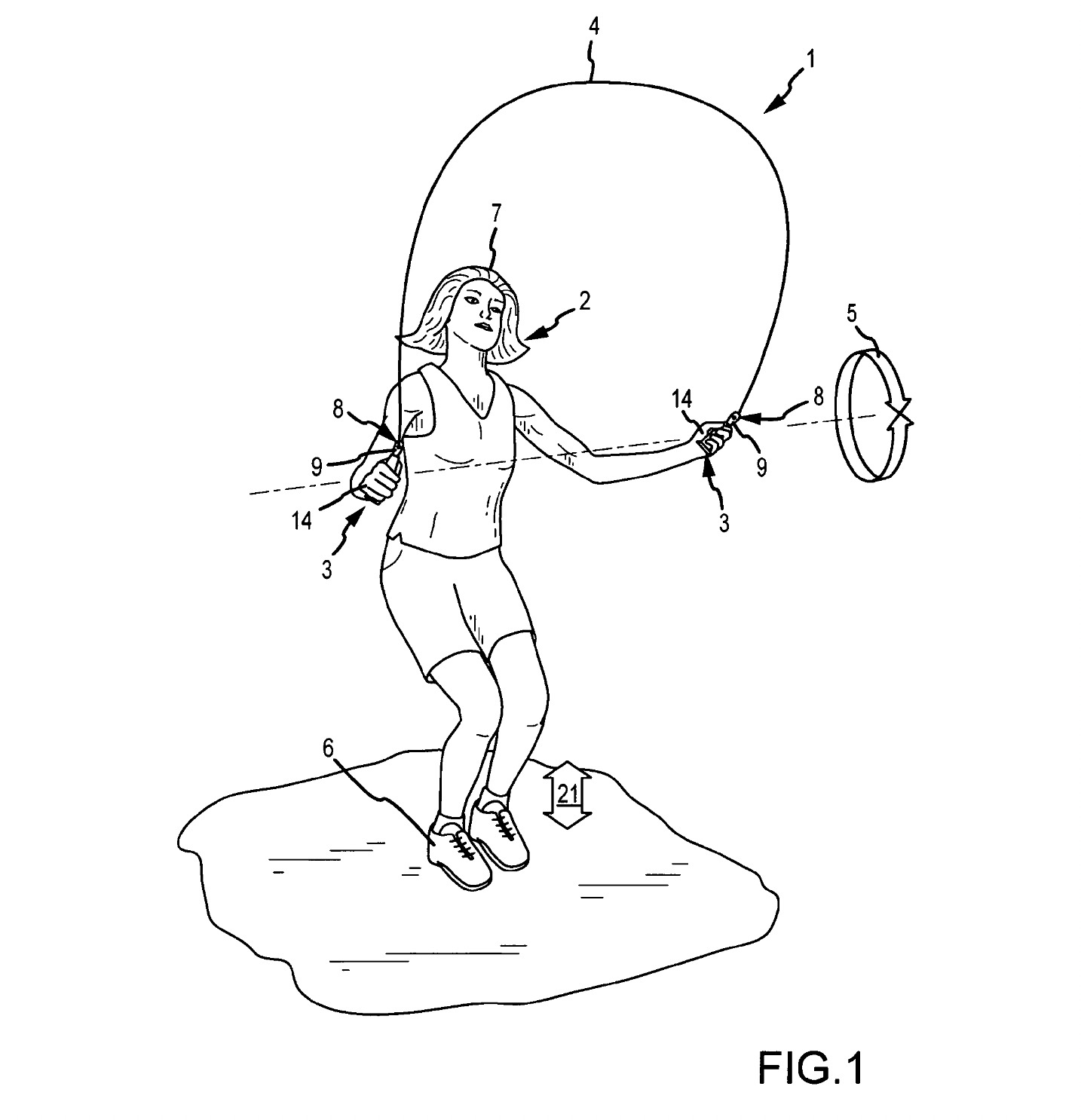“Rogue’s argument is circular and tautological: because the PTAB found claims unpatentable under a lower burden, JRS loses the protections of a higher burden in the other venue when litigating the identical issue. But ‘unpatentability’ is not a categorical truth; it is a litigation outcome among adversaries.”

US Patent 7,789,809 B2
The inventor of a novel jump rope system (the Revolution Rope), Molly Metz, argued in a reply brief to the U.S. Supreme Court filed on behalf of her company, Jump Rope Systems, LLC, on Tuesday that her case against Rogue Fitness is justiciable and the company has standing despite the cancellation of her patent claims by the U.S. Patent and Trademark Office (USPTO).
Jump Rope Systems filed the brief in reply to Rogue Fitness’s brief in opposition, which was filed on January 19.
Metz and Jump Rope Systems originally sued Rogue Fitness in 2018. But after Rogue filed a petition for inter partes review (IPR), the Patent Trial and Appeal Board (PTAB) ruled that Jump Rope Systems’ two patents (US 7,789,809 B2 and US 8,136.208 B2) related to jump rope handle technology were unpatentable.
The reply brief’s main contentions are that the cancellation of the patents did not end Jump Rope Systems’ right to sue Rogue for damages previous to the cancellation and that IPR violates due process.
The brief also reiterates the company’s previously filed petition asking the Supreme Court to “address the merits of the collateral-estoppel issue and overrule the Federal Circuit’s decision in XY, LLC.”
The Petition
In their September 2022 petition for a writ of certiorari, Metz’s lawyers made the case that the CAFC’s application of the collateral estoppel doctrine barring a patent infringement lawsuit based on the PTAB’s previous ruling of patent invalidity conflicts with the Supreme Court decisions in B&B Hardware, Inc. v. Hargis Indus., 575 U.S. 138 (2015); Medtronic, Inc. v. Mirowski Family Ventures, LLC, 571 U.S. 191 (2014); and Grogan v. Garner, 498 U.S. 279 (1991).
Additionally, Jump Rope Systems argued in the petition that the Supreme Court should take up the case because “this case…concerns a frequently recurring issue of nationwide importance in patent infringement litigation and presents an excellent vehicle for this court’s review of that important issue.”
In its reply brief, the company added: “the related issues of collateral-estoppel and justiciability arise in hundreds of patent-infringement cases each year and, thus, have a substantial effect on patent-infringement litigation.”
The company’s main gripe is that it was never permitted to have its patent infringement claims heard by an Article III court or federal jury due to “the Federal Circuit’s entrenched and oft-repeated misapplication of the collateral estoppel doctrine beginning in XY, LLC v. Trans Ova Genetics, L.C.”
Rogue Fitness’s Brief
Rogue’s brief in opposition presents four main reasons why the writ of certiorari should be denied.
First, Rogue argues that the petition is moot because Jump Rope Systems lacks standing following the USPTO’s cancellation of the claims on August 3, 2022—after the Federal Circuit’s decision in the case was issued.
The brief also argues that collateral estoppel applies because “cancellation of patent claims in an IPR must be binding on a parallel infringement litigation.”
The two final reasons that Rogue Fitness presents are precedent and that the case is a “poor vehicle for analyzing the issues presented.”
In its reply, Jump Rope Systems took issue with several cases that Rogue cited as precedent. Rogue argued that Jump Rope Systems had no patent rights since the PTAB ruled the claims were canceled. However, the reply brief argues the cited cases involved reissue patents, where patentholders voluntarily surrender the original patent, which Jump Rope Systems has not done.
Similarly, the reply brief takes issue with Rogue’s discussion of the collateral-estoppel doctrine. It contends that “Rogue’s arguments brushing off different standards and burden in an IPR versus a patent-infringement lawsuit lack merit.” The brief continues:
“Rogue’s argument is circular and tautological: because the PTAB found claims unpatentable under a lower burden, JRS loses the protections of a higher burden in the other venue when litigating the identical issue. But ‘unpatentability’ is not a categorical truth; it is a litigation outcome among adversaries. The Restatement exception (and Blonder-Tongue’s adoption thereof ) specifically exists to foreclose use of the low- burden outcome to obviate the high-burden challenge. No authority holds that a low-burden agency result justifies overlooking the higher Article III burden on the same issue.”
While Rogue argued this approach would make IPR proceedings “pointless”, Jump Rope Systems wrote that they would remain an alternative to litigation. “When a patentholder loses, and if IPR passes due process muster, no prospective injunction or damages would be possible for future infringement of the canceled patent,” argued the company in its brief reply.
A Long Journey
Molly Metz, the Colorado inventor behind Jump Rope Systems, told IPWatchdog in June 2022 about her precision speed jump rope handle, the patent infringement story, and her experience with the PTAB invalidating her patents.
“What happened to me is happening to others like me. Each week I get to hear from other inventors and their experience with PTAB. This system is broken and is ruining small businesses and the morale of U.S. innovators,” said Metz
When Metz noticed Rogue Fitness released a line of jump ropes using her patented technology, she filed a patent infringement lawsuit in 2018.
Subsequently, Rogue filed a petition for inter partes review, and the PTAB invalidated Metz’s two patents.
Several amici briefs have now been filed with the Supreme Court, including by Eagle Forum Education and Legal Defense Fund, the Fair Inventing Fund, DivX, the Fair Inventing Fund and Josh Malone.
Eagle Forum argued, “the loss is not merely to this inventor but to all future American inventors whose creative genius is thereby discouraged.”
This article was updated on February 2 to indicate additional amicus briefs have been filed with the Court.

![[IPWatchdog Logo]](https://ipwatchdog.com/wp-content/themes/IPWatchdog%20-%202023/assets/images/temp/logo-small@2x.png)

![[Advertisement]](https://ipwatchdog.com/wp-content/uploads/2024/04/Artificial-Intelligence-2024-REPLAY-sidebar-700x500-corrected.jpg)
![[Advertisement]](https://ipwatchdog.com/wp-content/uploads/2024/04/Patent-Litigation-Masters-2024-sidebar-700x500-1.jpg)

![[Advertisement]](https://ipwatchdog.com/wp-content/uploads/2021/12/WEBINAR-336-x-280-px.png)
![[Advertisement]](https://ipwatchdog.com/wp-content/uploads/2021/12/2021-Patent-Practice-on-Demand-recorded-Feb-2021-336-x-280.jpg)
![[Advertisement]](https://ipwatchdog.com/wp-content/uploads/2021/12/Ad-4-The-Invent-Patent-System™.png)






Join the Discussion
8 comments so far.
Albert Hardin
February 17, 2023 08:58 pmCorporate companies with the most money and connections within the system control the pieces, period. The key is layering you IP to the point that it’s publicly undeniable that you’ve been infringed. Then take those facts to the public and push your product as hard and as fast as you can.
James T.R
February 3, 2023 11:16 amThis issue…the whole matter of ROGUE stealing her patents has to be stopped! When a patent is issued and then the tech is stolen this act alone shows that whoever stole the tech/invention did not have the innovation prior to the patent being made public. So all this legal jargon is just smoke and mirrors so they can get away with it. There needs to be more protection laws in place besides just the now corrupted patent system that now has morphed into scam that is clearly being used by the Government and Larger Corporations to steal new inventions from independent inventors. This way they don’t have to pay for a creative person on their payroll or by an independent inventor; all they have to do is troll the current patent journal and when a patent is published they just take it. Knowing the new system ie the PTAB and USPTO itself will rule in their favor. It’s becoming just a huge legitimate but illegitimate scam against the average American citizen who is trying to be creative, ingenious or is a genius and wants to profit from it. It has to be fixed or as this article states its just a demoralizing thought to attempt to be successful from your creativity that produces your intellectual property. Just like when a baby is born the DNA proves who the parents are…no one can legally claim the child because the your DNA can’t be copied! A patent is supposed to be the inventors DNA.
concerned
February 3, 2023 05:10 amMaybe I should go out a buy a lottery ticket? I could be a lucky guy because I have not received a patent only to have the ensuing heartache of this inventor.
Josh Malone won his court battle and he still does not say good things about current patent affairs.
Model 101
February 2, 2023 07:38 pmMolly
The whole thing is a joke.
Downright crooked.
It was nice meeting you and Dirk
Paul
February 2, 2023 05:31 pmSending good money after bad. It’s over.
Eileen McDermott
February 2, 2023 04:44 pmSorry Josh – now noted.
F22strike
February 2, 2023 04:28 pmThe triad of Congress, the SCOTUS, and the USPTO has made US patents essentially worthless. Patents on the most valuable inventions will be serially attacked in IPRs and in seemingly endless court litigation. More and more companies are pursuing the policy of efficient infringement which has been sanctioned by the triad. They prefer to endure years of IPRs and court proceeding, and pay millions in legal fees, rather than enter into a license agreement or design around the asserted patent claims.
A company has two choices regarding a potentially valuable invention that its employees have invented: 1) spend $50K and 3-4 years to hopefully obtain a US patent; or 2) opt instead for no patent protection. Choice number 1 is a loser because either the invention never achieves commercial success, or if it does, the company cannot enforce the patent. Choice number 2 still potentially allows for some protection of non-mechanical inventions via trade secret laws and avoids a time consuming and expensive legal quagmire.
Companies pay thousands of dollars in USPTO fees to obtain a patent. They pay thousands more to maintain it. Then the USPTO collects tens of thousands in fees when it cancels its claims in an IPR proceeding and doesn’t refund the fees to the patent owner. Does anyone see a conflict of interest in this practice? The very substantial USPTO fee collections and the bonuses paid to PTAB judges clearly incentivize the extremely high rate of IPR petition grants and claim cancellations that are listed in the published IPR statistics.
The US patent system is clearly broken and big-tech has bought off Congress to ensure that there will be no fix. The voting public couldn’t care less about the health of the US patent system. CEOs and general counsels of US companies are not stupid. They will pare back their US patent application filings substantially. It appears that IBM has already responded in this fashion. It will take longer for foreign companies to get the message that they are, in most cases, wasting their money pursuing US patent protection.
Josh Malone
February 2, 2023 02:48 pmI also filed an amicus in this case.